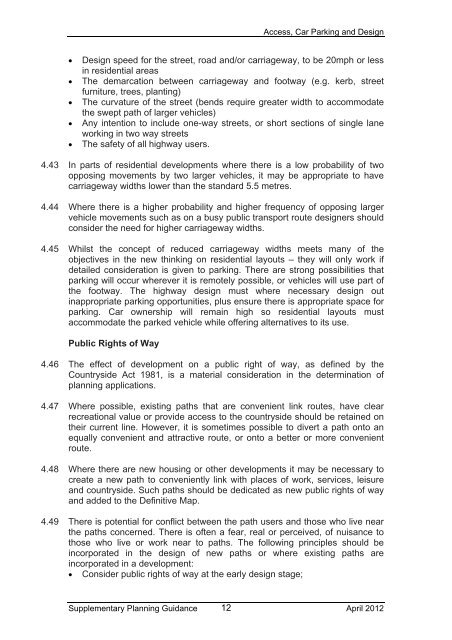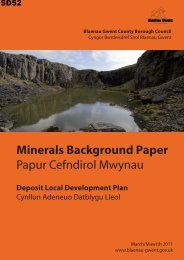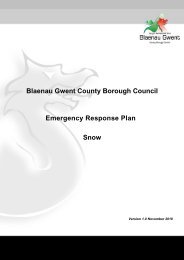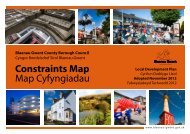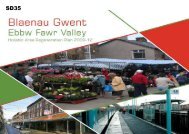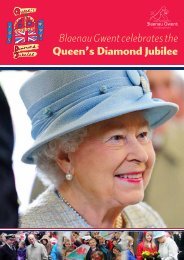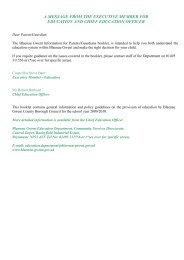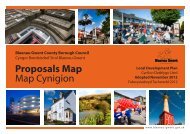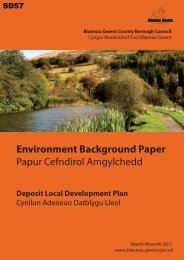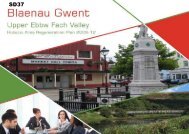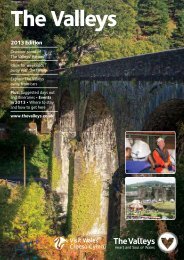Access Car Parking & Design - Blaenau Gwent County Borough ...
Access Car Parking & Design - Blaenau Gwent County Borough ...
Access Car Parking & Design - Blaenau Gwent County Borough ...
You also want an ePaper? Increase the reach of your titles
YUMPU automatically turns print PDFs into web optimized ePapers that Google loves.
<strong>Access</strong>, <strong>Car</strong> <strong>Parking</strong> and <strong>Design</strong><br />
<br />
<br />
<br />
<br />
<br />
<strong>Design</strong> speed for the street, road and/or carriageway, to be 20mph or less<br />
in residential areas<br />
The demarcation between carriageway and footway (e.g. kerb, street<br />
furniture, trees, planting)<br />
The curvature of the street (bends require greater width to accommodate<br />
the swept path of larger vehicles)<br />
Any intention to include one-way streets, or short sections of single lane<br />
working in two way streets<br />
The safety of all highway users.<br />
4.43 In parts of residential developments where there is a low probability of two<br />
opposing movements by two larger vehicles, it may be appropriate to have<br />
carriageway widths lower than the standard 5.5 metres.<br />
4.44 Where there is a higher probability and higher frequency of opposing larger<br />
vehicle movements such as on a busy public transport route designers should<br />
consider the need for higher carriageway widths.<br />
4.45 Whilst the concept of reduced carriageway widths meets many of the<br />
objectives in the new thinking on residential layouts – they will only work if<br />
detailed consideration is given to parking. There are strong possibilities that<br />
parking will occur wherever it is remotely possible, or vehicles will use part of<br />
the footway. The highway design must where necessary design out<br />
inappropriate parking opportunities, plus ensure there is appropriate space for<br />
parking. <strong>Car</strong> ownership will remain high so residential layouts must<br />
accommodate the parked vehicle while offering alternatives to its use.<br />
Public Rights of Way<br />
4.46 The effect of development on a public right of way, as defined by the<br />
Countryside Act 1981, is a material consideration in the determination of<br />
planning applications.<br />
4.47 Where possible, existing paths that are convenient link routes, have clear<br />
recreational value or provide access to the countryside should be retained on<br />
their current line. However, it is sometimes possible to divert a path onto an<br />
equally convenient and attractive route, or onto a better or more convenient<br />
route.<br />
4.48 Where there are new housing or other developments it may be necessary to<br />
create a new path to conveniently link with places of work, services, leisure<br />
and countryside. Such paths should be dedicated as new public rights of way<br />
and added to the Definitive Map.<br />
4.49 There is potential for conflict between the path users and those who live near<br />
the paths concerned. There is often a fear, real or perceived, of nuisance to<br />
those who live or work near to paths. The following principles should be<br />
incorporated in the design of new paths or where existing paths are<br />
incorporated in a development:<br />
Consider public rights of way at the early design stage;<br />
Supplementary Planning Guidance 12<br />
April 2012


